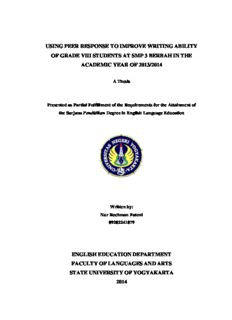
using peer response to improve writing ability of grade viii students at smp 3 berbah in the PDF
Preview using peer response to improve writing ability of grade viii students at smp 3 berbah in the
USING PEER RESPONSE TO IMPROVE WRITING ABILITY OF GRADE VIII STUDENTS AT SMP 3 BERBAH IN THE ACADEMIC YEAR OF 2013/2014 A Thesis Presented as Partial Fulfillment of the Requirements for the Attainment of the Sarjana Pendidikan Degree in English Language Education Written by: Nur Rochman Fatoni 09202241079 ENGLISH EDUCATION DEPARTMENT FACULTY OF LANGUAGES AND ARTS STATE UNIVERSITY OF YOGYAKARTA 2014 ii iii PERNYATAAN Yang bertanda tangan di bawah ini, saya: Nama : Nur Rochman Fatoni NIM : 09202241079 Jurusan : Pendidikan Bahasa Inggris Program Studi : Pendidikan Bahasa Inggris Fakultas : Bahasa dan Seni Judul Skripsi : USING PEER RESPONSE TO IMPROVE WRITING ABILITY OF GRADE VIII STUDENTS AT SMP 3 BERBAH IN THE ACADEMIC YEAR OF 2013/2014, menyatakan bahwa karya ilmiah ini adalah hasil pekerjaan saya sendiri. Sepanjang sepengetahuan saya, karya ilmiah ini tidak berisi materi yang ditulis oleh orang lain, kecuali bagian-bagian tertentu yang saya ambil sebagai acuan dengan mengikuti tata cara dan etika penulisan karya ilmiah yang lazim. Apabila terbukti pernyataan ini tidak benar, sepenuhnya menjadi tanggung jawab saya. Yogyakarta, 20 Juni 2014 Penulis, Nur Rochman Fatoni 09202241079 iv DEDICATIONS This thesis is dedicated to: My parents My brothers and sister My big family v MOTTOS Sholatlah Sebelum Kau Disholatkan Ujian dan Cobaan Pasti Akan Selesai, Itu Bukti Sayang Allah pada Kita (NRF 2013) Aku Bisa, Harus Bisa, Pati Bisa (forkot 2014) vi ACKNOWLEDGMENTS Alhamdulillahi Robbil’aalamiin. All praises be to Allah SWT, the Almighty God that gives His blessing so the writer can finish this thesis and his study. Invocation and peace go to Muhammad, the Prophet, his families, and his disciples. May Allah bless them and give them peace. The writer would like to thank to his beloved parents, lovely sister and brothers for all their love, motivation, support, prayers, and everything. He would like to express his gratitude and appreciation to her first supervisor, Dr. Agus Widyantoro, M.Pd. and his second supervisor Lusi Nurhayati, M.App.Ling., who have patiently guided him in doing the research and writing the thesis. He also would like to dedicate his gratitude to all lecturers in the English Education Department who have given him much knowledge and useful experience. His gratitude also goes to the big family of SMP 3 Berbah who has permitted the writer as the researcher to carry out the research. Furthermore, his gratitude also goes to Ahmad Zarkoni, S.Pd. who had become the collaborator of the research and gave him big supports to finish this thesis. He is thankful to the students of Class VIII D for their warmness and cooperation during the research. Moreover, he also wants to express special thanks to members of PBI Class D 2009, big family of UKM KARATE INKAI UNY, big family of FORKI KOTA Karate Team, big family of Kos Swakarya 30, members of EDULT, and all his friends in Yogyakarta and Sukoharjo for giving him much help, support, prayers, and motivation in doing the research; and also nice friendship. All of them are the best part of his life. vii Finally, the writer realizes that this thesis still has many mistakes. Therefore, he accepts gratefully any suggestions and comments. However, he hopes that the thesis will be able to give contribution and be useful for the readers especially for those who are interested in similar studies. Yogyakarta, June 20, 2014 The Writer, Nur Rochman Fatoni 09202241079 viii TABLE OF CONTENTS Page TITLE .................................................................................................................... i APPROVAL SHEET ............................................................................................ ii RATIFICATION .................................................................................................. iii PERNYATAAN ..................................................................................................... iv DEDICATIONS ..................................................................................................... v MOTTOS .............................................................................................................. vi ACKNOWLEDGEMENTS ................................................................................ vii TABLE OF CONTENTS ..................................................................................... ix APPENDICES .................................................................................................... xii LIST OF TABLES ............................................................................................ xiii LIST OF FIGURE AND CHARTS ................................................................. xiv ABSTRACT ........................................................................................................ xv CHAPTER I INTRODUCTION A. Background of the Study ........................................................................... 1 B. Identification of the Problem ..................................................................... 5 C. Problem Limitation .................................................................................... 7 D. Formulation of the Problem ....................................................................... 8 E. Objective of the Study ................................................................................ 8 F. Significance of the Study............................................................................ 8 CHAPTER II LITERATURE REVIEW AND CONCEPTUAL FRAMEWORK A. Literature Review ................................................................................... 10 1. Theories of writing ............................................................................... 10 a. Definitions of writing ...................................................................... 10 b. The writing process ......................................................................... 12 c. Characteristics of written language ................................................. 15 d. Micro and macro skills of writing ................................................... 17 2. Teaching writing in Junior High School .............................................. 19 ix a. Principles of teaching writing .......................................................... 19 b. Type of writing activities ................................................................ 23 c. Characteristics of Junior High School students ............................... 25 d. Teaching writing in Junior High School ......................................... 26 3. Peer Response ...................................................................................... 29 a. The nature of Peer Response ........................................................... 29 b. The Importance of Peer Response .................................................. 31 c. The implementation of the Peer Response in Teaching Writing ..... 34 B. Relevant Studies ....................................................................................... 37 C. Conceptual Framework ............................................................................ 39 CHAPTER III RESEARCH METHOD A. Type of the Research ............................................................................... 42 B. Research Setting ....................................................................................... 44 1. Place Setting......................................................................................... 44 2. Learning Setting ................................................................................... 45 3. Time Setting ......................................................................................... 46 C. Participant of the Research ...................................................................... 47 D. Instrument of the Research ...................................................................... 47 E. Data and Technique of Collecting Data ................................................... 48 F. Technique of Data Analysis ..................................................................... 50 G. Validity and Reliability ............................................................................ 52 H. Procedure of the Research ....................................................................... 55 1. Reconnaissance Stage .......................................................................... 55 2. Plan of Action ...................................................................................... 56 3. Action ................................................................................................... 56 4. Reflection ............................................................................................. 57 CHAPTER IV RESEARCH FINDINGS AND DISCUSSION A. Reconnaissance ........................................................................................ 58 1. Identification of the Problem ............................................................... 58 2. The Selection of the Problem ............................................................... 63 x
Description: